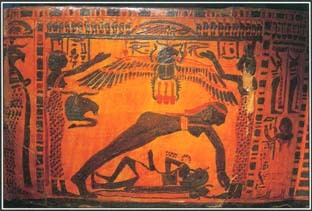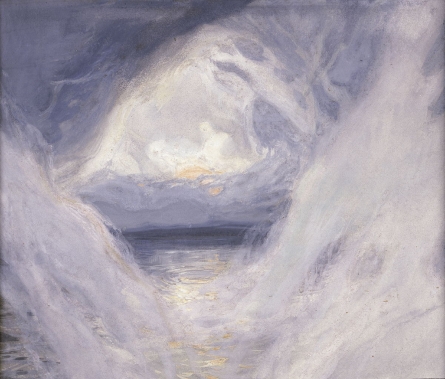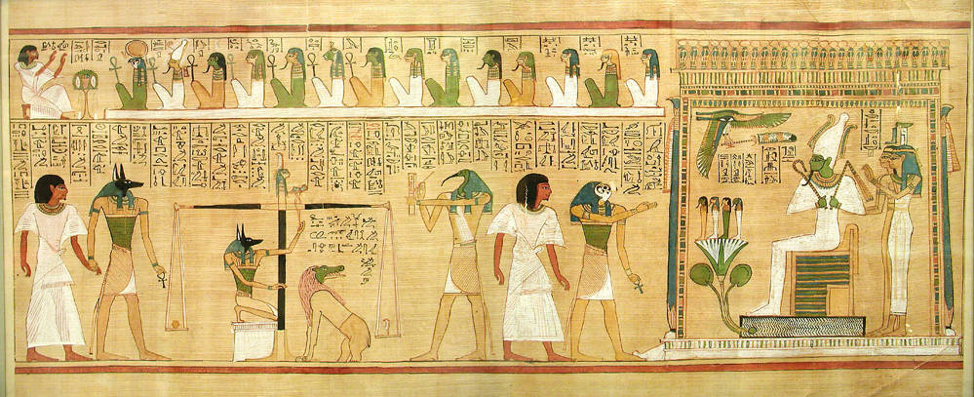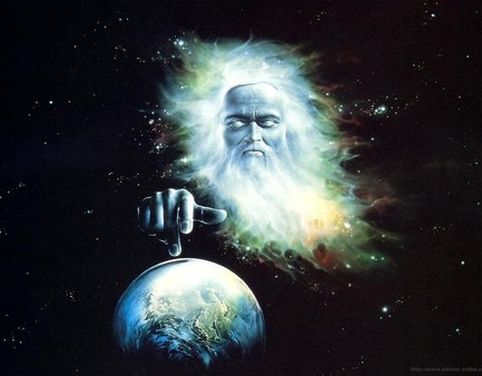Creation Stories of the Ancient Egyptians: Order (Maat) from Chaos
Cultural Context
As Charlie began to delve into the mythology of the Ancient Egyptians, and in particular their cosmology, or mythological description of the origins of the known universe, he found that a narrative of mythology or a book of writings on the topic (like that of Ovid for the Romans for example) was lacking. To find out about Egyptian creation myths then, Charlie had to parse through Egyptian texts that described hymns, magical rites, funeral rites and rituals, along with some reference to Egyptian mythology from Plutarch, the first century AD Greek historian and philosopher. Charlie of course didn’t read any form of Egyptian, nor did he read Greek or Latin, so he had to rely on second hand interpretations and translations of all of the extant materials
But what struck Charlie as unique to the Egyptians though, was the variety of interpretations of Egyptian myth in general. There wasn’t just one creation myth, there were several versions, each with basically the same cast of characters, but yet each subtly different in its own way. But based on his studies of the Ancient Egyptian culture though, Charlie thought that this was not due to a lack of formal mythology of the Ancient Egyptians, as some scholars postulated, but due to the age or maturity of the civilization itself.
Charlie knew enough about Ancient Civilizations, as well as the origins of mankind from an anthropomorphic, archeological and genetic standpoint, that as you went further back into history, the historian had to rely less on actual firsthand accounts, or the mature formalization of ideas and principles, and more on archeological evidence and second hand accounts from later historians. And that was what Charlie was represented with for the most part when he delved into the mythology of the Ancient Egyptians.
What was somewhat unique about the Ancient Egyptians, Charlie thought, and you could make the same argument for all of the earliest civilizations, is that the civilization was primarily marked by a loose configuration of peoples that were bound by a geographical and cultural construct. In contract to the Greek or Roman civilizations for example, where the culture, and in turn the mythology and theology, was more consistent and coherent reflecting the predominant cultural influence that the Greeks and Romans had on all of its peoples.
The Egyptian civilization formed primarily around the shared experience of the Nile River, and its annual cycles. You had Lower and Upper Egypt[1] (lower being the more northern parts of Ancient Egypt which never ceased to confuse Charlie), and they were bound by the dependence on the fertilization power of the Nile. Most ancient civilizations were formed out of combined, collective social experience and organization around river valleys, such as Sumer around the Tigris-Euphrates, and Ancient Egypt was no exception.
The mythology, and in turn the cosmology, of the Ancient Egyptians reflected this hodge-podge relationship of its peoples, along with the collective experience and attachment to cyclical nature of the people’s relationship with the Nile river. Much of their mythology and theology in turn, evolved from this relationship with the annual cycle of the flooding of the Nile, around ideas of a cycle, and natural order of things that repeated itself – the rising and setting of the sun god Ra every day for example, or the cycle of the birth and death of the divine ruler, or the pharaoh.
One of the more marked and unique aspect of Egyptian mythology, and in turn Egyptian culture and society, was the importance of the cycles of the day and the year. According to most historians, and Charlie most definitely agreed with their interpretation in this regard, the Egyptian focus and obsession with the cycle of life, marked most notably by the passage of the sun across the sky and the annual flooding of the Nile, reflected the great cultural and sociological dependence on the Nile for food and nourishment. And this annual flooding of the Nile was in turn a primary focus of the society to ensure their survival.
The primary focus of the Egyptian religion then, and the intent of most of their rituals and religious ceremonies, was to ensure that the cyclical events of nature that ensured their survival continued to occur on a regular basis, an effort to maintain the natural order of maat[2]. Maat, or Ma’at, to the Ancient Egyptian represented the fixed, eternal order of the universe, both in the cosmos and in human society. Maat had always existed, and would always exist, and it was the ever present and all pervading principle that provided the order and structure to the known universe.
Common Themes and Sources
But regardless of the variety of creation myths that existed throughout ancient Egypt, Charlie found that for the most part they all shared a common component; that is the emergence of the world from a primordial ocean of chaos. One version for example described the manifestation of Atum, one of the ancient Egyptian sun gods, out of this primordial soup which was called Nu. Atum then created Shu and Tefnut, gods of air and moisture respectively, who then in turn gave birth to Geb, Earth, and Nut, Sky, from which the rest of the Egyptian deities emerged.
In another version of the creation myth, Khepri, an aspect of the sun god and depicted as a scarab[3], establishes maat, as well as creates Shu and Tefnut once again out of the primordial chaos called Nu, who in turn gave birth to Geb and Nut. Regardless of these variations, the act of creation represented the initial establishment of maat and the pattern for the subsequent cycles of time.
The scarab, or dung beetle, was an important figure in Egyptian mythology. These beetles are best known for rolling and collecting round balls of dung, which the Egyptians used as an analogy for the pushing of the sun across the sky and through the underworld in its daily cycle. Hence the association of Khepri, depicted by a scarab, with the sun god Ra.
Charlie found a good explanation for this concept of Nun, or the primordial abyss from which the universe came forth:
Nu (“Watery One”) or Nun (“The Inert One”) is the deification of the primordial watery abyss. The Ancient Egyptians envisaged the oceanic abyss of the Nun as surrounding a bubble in which the sphere of life is encapsulated, representing the deepest mystery of their cosmogony. In Ancient Egyptian creation accounts the original mound of land comes forth from the waters of the Nun. The Nun is the source of all that appears in a differentiated world, encompassing all aspects of divine and earthly existence.
Nu was shown usually as male but also had aspects that could be represented as female or male. Naunet (also spelt Nunet) is the female aspect, which is the name Nu with a female gender ending. The male aspect, Nun, is written with a male gender ending. As with the primordial concepts of the Ogdoad, Nu’s male aspect was depicted as a frog, or a frog-headed man. In Ancient Egyptian art, Nun also appears as a bearded man, with blue-green skin, representing water. Naunet is represented as a snake or snake-headed woman.[4]
Established at the creation of the world, the presence of maat represents the evolution of the universe into a system of order and law, as distinguished from the chaos or primordial soup which preceded it. The concept of maat encompassed not only the cosmic principle of order and law, but also the law and order of society at large, and also the normal functioning of the forces of nature, all of which allow for the happiness of the individual, as well as the collective civilization. So maat, as Charlie understood the concept at least, represented a core part of the belief system of the Ancient Egyptians, and in turn had a cosmological context within which the term was viewed, even if it referred to the social or natural order of the known universe.
The importance of this concept to the Ancient Egyptians is most clearly illustrated by the fact that the maintainer and shepherd of this concept of maat in this world was the Pharaoh. And his job you could say, was to implement and manifest the universal world order to the order and law in the known universe, the daily lives of the Ancient Egyptians. The Pharoah’s role you could say was to interpret and reflect the cosmic order to the social order, maintaining life and society at large by ensuring that the gods were pleased and sustained with offerings and rituals, and the importance of this principle was upheld by the general population.
The concept of the underworld, and its relation to the sun god Ra, was another one of the distinguishing characteristics of Egyptian religion and mythology, and one which Charlie could not necessarily find a counterpart to in the mythology of the Greeks or Romans. The Egyptians believed that Ra made had to pass through the underworld every night in order to rise again the following day. The idea of the underworld, and its relation to human existence was a large part of the theological and philosophical context within which the Egyptian lived, and was a large part of their theological system of beliefs.
Conclusion: The Cycle of Life and Resurrection
From Charlie’s perspective, the Egyptian culture, more so than any other, was marked by their fascination with death and the afterworld. They had a fascination with the intimate connection of death with life, a concept that carried over to some degree to Greek and Roman mythology in their idea of Hades[5] (Pluto to the Romans). When you think of Ancient Egypt, Charlie mused, you had to think of their mummies for example. But Charlie thought this was more a reflection of the archeological record, which primarily rested in the study of the tombs of the ancient pharaohs of Egypt and the associated hieroglyphics, rather than a reflection of the Egyptian culture itself.
Looking at it another way, if you looked at current society and culture primarily through the lens of our funeral ceremonies, you’d be left with a somewhat skewed version of the reality of present day. But when looking that far back in time, sometimes that was all you had to go with, i.e. religion and funeral rites.
But from the tombs of the pharaohs, and the written record that accompanied these tombs inscribed on their walls and entranceways, you could see a glimpse of the of the myths of creation, which varied from region to region throughout Ancient Egypt, but still had some very consistent themes throughout. The core cosmology of the Ancient Egyptian culture, Charlie found, was that the core Gods and Goddesses emerged out of a primordial chaos or abyss. Their society reflected this concept, and its underlying cyclical nature, in their worship of the Pharaoh as a manifestation of the divine, and in their focus on ritual and sacrifice to the gods to retain this order and balance in their world.
Again from Charlie’s perspective, he thought that the reason that ancient Egyptian historians focused on this cyclical and mythical aspect of the Egyptian culture was because most of the firsthand accounts and descriptions that were left for the historian to analyze came from the remnants of ancient ritual and worship, and of course from the tombs of the dead, all of which illustrated this cyclical and codependent relationship between life and death, and the desire for immortality, which represented a fundamental tenant of their philosophy and belief system.
It would be interesting, thought Charlie, to get a firsthand account of the religious and theological beliefs of an Ancient Egyptian tradesman or craftsman to get a better understanding of their concept of religion and theology. Did they really think that their pharaoh was divine? Did they really think that if they built a great tomb for themselves, and preserved their bodies like the pharaohs and other members of royalty did that they would truly live forever? But that didn’t exist unfortunately, and Charlie was left with the main historical record, which again represented primarily by the inscriptions of the tombs of the pharaohs, and the record of religious ceremonies.
[1] In Ancient Egypt, Lower Egypt was to the north (in the region of the Nile Delta) and to the south was Upper Egypt. The two kingdoms of Upper and Lower Egypt were united around the third millennium BC, but each region maintained some level of autonomy. The terminology “Upper” and “Lower” derives from the flow of the Nile from the highlands of East Africa northwards to the Mediterranean Sea. Incidentally, the Nile is only main river system that flows from south to north and its name is derived from the Greek “Nelios”, meaning River Valley.
[2] Maat was the ancient Egyptian concept of truth, balance, order, law, morality, and justice. Maat was also personified as a goddess regulating the stars, seasons, and the actions of both mortals and the deities, who set the order of the universe from chaos at the moment of creation. Later, as a goddess in other traditions of the Egyptian pantheon, where most goddesses were paired with a male aspect, her masculine counterpart was Thoth and their attributes are the same. After the rise of Ra they were depicted together in the Solar Barque. After her role in creation and continuously preventing the universe from returning to chaos, her primary role in Egyptian mythology dealt with the weighing of souls that took place in the underworld, Duat. Her feather was the measure that determined whether the souls (considered to reside in the heart) of the departed would reach the paradise of afterlife successfully. Pharaohs are often depicted with the emblems of Maat to emphasize their role in upholding the laws of the Creator.
[3] The scarab, or dung beetle, was an important figure in Egyptian mythology. These beetles are best known for rolling and collecting round balls of dung, which the Egyptians used as an analogy for the pushing of the sun across the sky and through the underworld in its daily cycle. Hence the association of Khepri, depicted by a scarab, with the sun god Ra.








Trackbacks & Pingbacks
insurance
You my acquaintance are a genius
[…] had looked at the cosmological traditions of the Ancient Sumer-Babylonian culture, the cosmology of the Ancient Egyptians, the cosmology of the Ancient Greeks, the Indo-Aryan theological and metaphysical tradition that […]
[…] for a look at Sumer-Babylonian ties between cosmological beliefs and authority and https://snowconesdiaries.com/2012/07/21/the-cosmology-of-the-egyptians-religion-and-power/ for a review of the connection between the priestly class of the Egyptians, namely the pharaohs, […]
Leave a Reply
Want to join the discussion?Feel free to contribute!